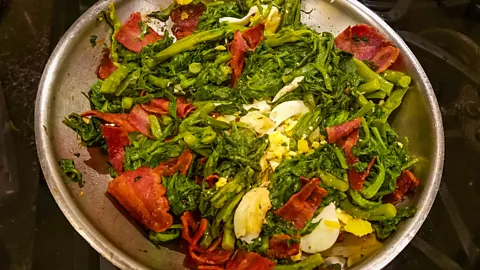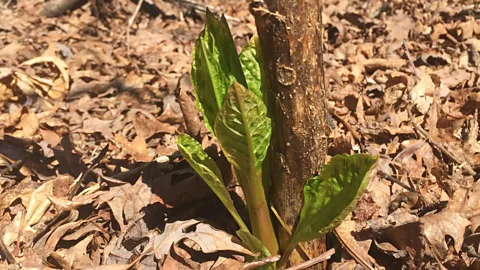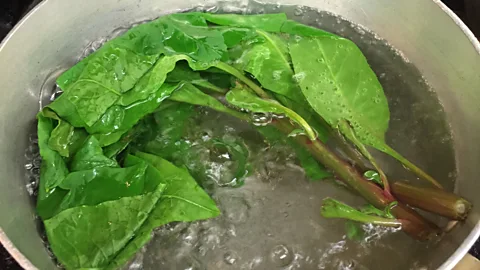A forgotten food of the American South
 Susan Vineyard/Getty Images
Susan Vineyard/Getty ImagesPokeweed – a green that’s toxic if prepared incorrectly – has been eaten throughout the American South, and could be having a renaissance thanks to the local foraging movement.
It was Mother’s Day weekend, and late spring teased the three-month inferno that North Carolinians call summer. I’d been waiting for this moment: for the first time in my adult life, I was planting a proper garden.
As I marked off the boundaries for the compost heap, a tiller hummed alongside me, simultaneously ripping up chunks of red clay earth on one side and spitting pulverised, marble-sized fragments out the other. Its operator finished the last row, leaned over the clunky equipment and let out a long, deep sigh – the kind that comes from physical labour.
“You’ve got a bunch of poke salad over there,” he said casually, gesturing towards the chain-link fence running the border of my property.
My eyes followed his gaze, settling on the tall, leafy stalks of vibrant greens along the fence. As soon as he said the words – poke salad – a stream of memories flooded my brain: how my mother and aunts would pull the car over on a country road to pick a good patch of poke salad, also called pokeweed; the quick and precise way they snapped the leaves from their stalks; the smell of my great-grandmother preparing the bounty in her kitchen, finishing the dish with bacon grease scooped from an old Crisco can she kept on the stove.
 Davina van Buren
Davina van BurenYou may also be interested in:
• The deadly dish people love to eat
A wild green that grows abundantly throughout the United States, pokeweed is especially plentiful in Appalachia, a cultural region that follows the Appalachian Mountains from southern New York State to north-eastern Mississippi, as well as the rest of the American South. The cooked, finished greens are called poke sallet; and ‘polk salad’, a spelling popularised in Louisiana native Tony Joe White’s 1969 swamp-rock hit Polk Salad Annie. I hadn’t heard the words since I left my sleepy hometown of Sanford, a rural town (at least when I lived there) located smack dab in the middle of North Carolina, 25 years ago.
After spending the last decade of that time away as a Colorado-based digital nomad and taking an eight-month sojourn in Mexico, I’d just returned to North Carolina. Now that I had an actual yard, I was determined to grow at least some of my own food. Looking at the showy greens lining the fence, I suddenly wondered: do people still eat poke sallet?
The short answer is yes and no. If you ask older Southerners, many still eating poke sallet, or at least knowing someone who did. But millennials? Forget about it. I asked dozens of people about poke sallet after the tiller incident in my garden, and not a single person under the age of 40 had a clue what I was talking about. To understand why it disappeared from Americans’ tables – and why it’s experiencing a slight renaissance due to the foraging movement – one must delve into the green’s storied history.
Pokeweed was a dietary staple throughout Appalachia for generations. “It was a food that you ate mostly because you were poor, and that’s not necessarily something that everyone wanted to embrace,” said Mike Costello, chef and farmer at Lost Creek Farm in West Virginia. As subsequent generations became more financially successful than their parents’, the need to forage wild foods dwindled.
“Most narratives about foods like poke sallet are associated with shame, poverty or desperation – but to me, the story is more about ingenuity and resourcefulness,” Costello said. “Those are things that people can be proud of.”
 Susan Vineyard/Getty Images
Susan Vineyard/Getty ImagesIf you live in the south-eastern US, you’ve likely seen plenty of pokeweed growing wild and never knew the name. The hardy perennial plant can grow up to 10ft tall and thrives almost anywhere: beside ditches, along fences, near livestock pastures, even in deserted city lots. Once mature, it has unmistakably flamboyant foliage, thick, magenta-tinted stems, and dark purple or black berries.
Like many foraged foods, pokeweed comes with a catch: it can be toxic if prepared incorrectly.
“In Appalachia, living off the land was an important element years ago, and a lot of our older generation still what you can and cannot eat in the wild,” said Brandon Pennington, executive director of the City of Harlan Tourist and Convention Commission, which hosts the annual Poke Sallet Festival in Harlan, Kentucky. “However, with mass farming and food being so immediately available in our world, that art is lost.”
 Davina van Buren
Davina van BurenThough the berries of the poke plant have been used for everything from ink to lipstick (Dolly Parton famously wrote about the latter in her inspirational book Dream More: Celebrate the Dreamer in You), you should never eat them – nor the roots, stalk, seeds or raw leaves of the pokeweed. Powerful toxins reside in these parts of the plant and although no deaths from eating poke sallet have been officially recorded in modern times, children frequently get sick from eating the berries, which resemble wild grape clusters when mature. Most often, symptoms include severe stomach cramps, rapid heartbeat, vomiting, diarrhoea and difficulty breathing.
Pokeweed’s toxicity increases as the plant matures, especially in the root system, which should be avoided altogether at all growth stages. Leaves are the least toxic parts of the poke plant, followed by the stems and berries. That’s why only the leaves of young spring plants should be picked, and then cooked thoroughly. It was through trial and error that Native Americans, African slaves and other people from the region figured out the delicate balance of how to prepare and consume this bountiful, early-sprouting green without becoming unwell.
The first time or two, it’s best to pick pokeweed with someone who knows their stuff; otherwise, you may mistake poke for just another weed. Or, if you can identify the mature plant (which is much easier due to the distinctive purple stalk and berries), you can mark the spot and return the following spring when the perennial plant is young and edible. The wide, almond-shaped leaves should be picked while the plant is young and tender – ideally between 1ft to 2ft high – and before there is any purple at all on the stalk, stems or leaves.
Now comes the (questionably) fun part: the raw leaves should be rinsed and boiled to remove the plant’s toxins. Cover with water, bring to a boil, and then drain and ‘squeeze’ the greens using a spatula or wooden spoon. Repeat this process three times, then sauté the greens in a pan with bacon grease and seasoning like salt and pepper to taste. It’s a time-consuming process, and like most greens poke cooks down dramatically, so you need a lot of it for just a few servings. Some say poke sallet tastes like turnip greens or spinach, with a slight iron or mineral aftertaste.
So why would anyone go to all this trouble to cook a weed that can make you sick? “It’s something that represents more than just flavours or ingredients,” Costello said. “It’s a piece of who you are and your connection to those landscapes.”
 Davina van Buren
Davina van BurenWill pokeweed the ranks of trendy foraged foods like ramps and chanterelle mushrooms? Probably not. However, there are a handful of chefs who are brave enough to serve it to the masses. Chef Clark Barlowe, owner of Heirloom in Charlotte, North Carolina, grew up surrounded by pokeweed in the western part of the state, but had never seen it prepared.
“When I opened the restaurant in 2014, I had a renewed interest in it and asked my Nana – my mom’s mother – to teach me about the preparation,” he said. “From there, it was simply a matter of teaching my cooks the technique, foraging some young poke, and we were off to the races.”
Each spring, Barlowe features the green on Heirloom’s tasting menu for one month while it is in prime season. “We have a poke patch that grows right next to the restaurant so it’s a fairly easy get for us, and some regular customers bring us the perfect-sized leaves when they are weeding their yards.”
 Davina van Buren
Davina van BurenUndoubtedly, some chefs are intimidated by serving potentially toxic foraged foods. But Barlowe is confident in his staff and cooking technique – the same three-boil method Nana used. In the past, he’s served pokeweed ice cream made with juice from those exotic, dark purple berries (which must be carefully pressed to avoid breaking any poisonous seeds), and next spring he plans to experiment with a ‘poke punch’ recipe from the 1800s, a simple concoction of orange juice, soda water, mint and pokeweed juice. Barlowe says he may put a slight twist on the recipe by adding what he calls ‘rooftop honey water’, a secondary product that comes from making beeswax from the honeybees he keeps on the restaurant’s roof.
You can also grab a poke sallet plate with all the fixings at the Poke Sallet Festival in late May and early June. Otherwise, it looks like it’s up to the home cooks of Appalachia and the US South, foodies, and foragers to keep the tradition of preparing poke sallet alive.
Culinary Roots is a series from BBC Travel connecting to the rare and local foods woven into a place’s heritage.
more than three million BBC Travel fans by liking us on Facebook, or follow us on Twitter and Instagram.
If you liked this story, sign up for the weekly bbc.com features newsletter called "If You Only Read 6 Things This Week". A handpicked selection of stories from BBC Future, Culture, Capital and Travel, delivered to your inbox every Friday.
{"image":{"pid":""}}
